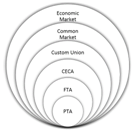

Context
India and Australia have signed a new trade deal. It is a historic deal and the two countries are looking at each other to make the most of this agreement.
Background
- India and Australia enjoy excellent bilateral relations that have undergone transformative evolution in recent years, developing along a positive track, into a friendly partnership.
- This is a special partnership characterized by shared values of a pluralistic, parliamentary democracies, Commonwealth traditions, expanding economic engagement, long standing people-to-people ties and increasing high level interaction.
- The India-Australia Economic Cooperation and Trade Agreement (Ind-Aus ECTA), was signed on April 2, 2022.
- This has been called a historic deal for India for a reason.
- India has never had an agreement of this scale with a 'developed nation' in about a decadeand this agreement marks the moment of change for India.
- This is the third free trade agreement for India, who has previously signed similar trade agreements with Japan and Korea.
Analysis
Quick summary of the Agreement
- Aim: The aim is to enhance the bilateral trade to $45 billion in the next five years (currently at $27.5billion), with a clear focus on job creation and exports.
- Australia will get a greater market access for a range of its products like sheep meat, wool, wine, coal, alumina and metallic ores while Indian service professionals will get easier access to employment opportunities.
- Zero-duty access: Australia is offering zero duty access to India for about 96.4 per cent of exports (by value) from day one. This covers many products which currently attract 4-5 per cent customs duty in Australia.
- Pharma sector: For the pharma segment, the pact would provide fast-track approvals and fast-track quality assessment/inspections of manufacturing facilities.
- Cheaper raw material: Since Australian exports are more concentrated in raw materials and intermediates, many industries in India will get cheaper raw materials which will make them competitive, in particular sectors like steel, aluminium and fabric/ garments.
- Tariff reduction: The comprehensive IndAus ECTA provides for competitive tariff elimination or tariff reduction on a wide range of goods and opens new services markets for suppliers across both markets.
- Australia trades in about 6,500 tariff lines, while India has over 11,500 tariff lines.
- Service sector: In the services space, some of the key offers from Australia include: quota for chefs and yoga teachers; post study work visa of 2-4 years for Indian students on a reciprocal basis; mutual recognition of professional services and other licensed occupations; and work & holiday visa arrangement for young professionals.
- Labour-intensive sectors: Labour-intensive sectors which would gain immensely include textiles and apparel, few agricultural and fish products, leather, footwear, furniture, sports goods, jewellery, machinery, electrical goods and railway wagons.
|
Status of India’s current trade with Australia:
|
Excluded Items:
- To safeguard sensitive sectors, India has several goods in the exclusion category in which no duty concessions will be accorded to Australian imports.
- Such goods will include milk and other dairy products, toys, sunflowers, seed oil, walnuts, pistachio nuts, platinum, wheat, rice, bajra, apple, sugar, oil cake, gold, silver, chickpeas, jewellery, iron ore and most medical devices.
About Free Trade Agreement:
- A free trade agreement (FTA) is an agreement where two or more countries agree to provide preferential trade terms, tariff concession etc. to the partner country.
- In this agreement, a negative list of products and services is maintained by the negotiating countries on which the terms of FTA are not applicable hence it is more comprehensive than preferential trade agreement.
|
Types of Regional Trading Agreements: Regional trading agreements vary depending on the level of commitment and the arrangement among the member countries.
|
Impact of the Agreement
- The two-way trade between India and Australia has always grown over time.
- The value of trade grew from $13.6 billion in 2007 to $24.3 billion in 2020 to $27.5 billion at present.
- Now, with a trade deal in place, bilateral trade is expected to touch $45 billion in the next five years.
- The agreement will see both governments secure alternative supply chains with each other and counter China by slashing duties on more than 85% of export goods. It is expected to be implemented in the coming four months.




